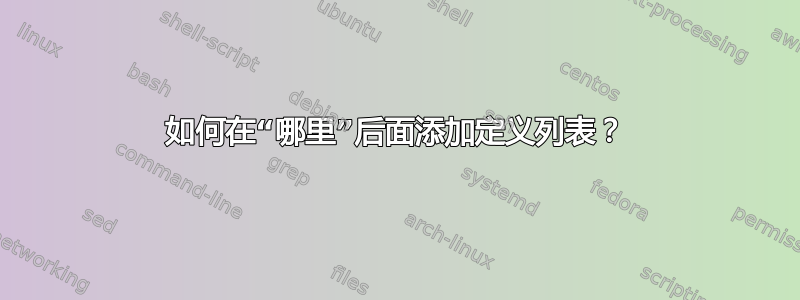
我有一个小等式,其中有两个支持项来解释这个等式。
\begin{equation}
[\mathrm{d}[\mathrm{i}], \mathrm{a}[\mathrm{i}]]=\mathrm{f}_{i}(\mathrm{M}[\mathrm{i}] \cdot \mathrm{f})
\end{equation}
where $\mathrm{d}[\mathrm{i}] \in \mathbb{R}^{B \times n_{d}}$ and $\mathrm{a}[\mathrm{i}] \in \mathbb{R}^{B \times n_{a}}$ \vspace{0.5\baselineskip}
在论文中看起来不太整洁。我正在使用 mathptmx,但没有得到好的结果。我怎样才能让它看起来更好。
编辑
\begin{equation}
[d[i], a[i]] = f_{i}(M[i]\cdot f)
\end{equation}
where $d[i] \in \mathbb{R}^{B \times n_{d}}$ and $a[i] \in \mathbb{R}^{B \times n_{a}}$ \vspace{0.5\baselineskip}
答案1
这取决于个人喜好,但这是我的建议。
首先,您可以使用\shortintertext{where}from mathtoolswithin asplit来引入定义。
其次,我擅自将外括号和圆括号的尺寸设置得比内括号大一号。
\documentclass{article}
\usepackage{mathtools} % For \shortintertext
\usepackage{unicode-math} % For \setmathfont
\defaultfontfeatures{Scale = MatchLowercase, Ligatures = TeX }
\setmainfont{TeX Gyre Termes}[Scale=1.0] % Modern version of times or newtxtext
\setmathfont{TeX Gyre Termes Math} % Modern version of mathptmx or newtxmath
%% To format the MWE for TeX.SX:
\usepackage[paperwidth=10cm]{geometry}
\pagestyle{empty}
\begin{document}
\begin{equation}
\begin{split}
\bigl[ d[i], a[i] \bigr] = f_{i}\bigl( M[i]\cdot f \bigr)
\shortintertext{where}
\qquad d[i] \in \mathbb{R}^{B \times n_{d}} \textnormal{ and } a[i] \in \mathbb{R}^{B \times n_{a}}
\end{split}
\end{equation}
\end{document}
该解决方案还保留了对齐点,因此您可以对齐定义列表,如下所示:
\documentclass{article}
\usepackage{mathtools} % For \shortintertext
\usepackage{unicode-math} % For \setmathfont
\defaultfontfeatures{Scale = MatchLowercase, Ligatures = TeX }
\setmainfont{TeX Gyre Termes}[Scale=1.0] % Modern version of times or newtxtext
\setmathfont{TeX Gyre Termes Math} % Modern version of mathptmx or newtxmath
%% To format the MWE for TeX.SX:
\usepackage[paperwidth=10cm]{geometry}
\pagestyle{empty}
\begin{document}
\begin{align}
\begin{split}
\qquad \bigl[ d[i], a[i] \bigr] &= f_{i}\bigl( M[i]\cdot f \bigr)
\shortintertext{where}
d[i] &\in \mathbb{R}^{B \times n_{d}} \\
a[i] &\in \mathbb{R}^{B \times n_{a}}
\end{split}
\end{align}
\end{document}
这样会在页面上留下很多空白,如果是印刷版教科书,你可能会更在意这一点。从好的方面来看,纸张是一种极好的碳吸收剂!
您可以根据自己的喜好进行调整,例如更改行的水平间距或使用\begin{multilined},仅将变量定义列表放在嵌套aligned环境中等。
如果您不喜欢将“where”放在单独的一行,您可以\shortintertext{where}用替换\textnormal{ where }。
答案2
这在某种程度上是基于观点的,但无论如何我都会说我将如何对待这项业务,因为其中涉及到印刷和数学特征。
首先,方程编号仅与方程有关,与解释性条款无关。此外,这似乎是高级数学(可能是研究论文),所以我首先假设我的读者做知道我在说什么。例如,此时他们已经知道乙,nd和nA意思是。
您只需要指定方程式中的符号,因此只需在方程式后面添加解释即可。我总是从读者可以阅读的原则出发,数学文本(尤其是研究论文中的数学文本)应该尽可能简单明了。
换句话说,解释性条款不需要特殊的格式:当读者看到等式时,他们会继续阅读并找到条款。
\documentclass[twocolumn]{article}
\usepackage{amsmath}
\usepackage{newtxtext,newtxmath}
\usepackage{lipsum} % for mock text
\begin{document}
\lipsum[1][1-3]
We can state our main equation
\begin{equation}
\bigl[d[i], a[i]\bigr] = f_{i}(M[i]\cdot f)
\end{equation}
where $d[i] \in \mathbb{R}^{B \times n_{d}}$ and $a[i] \in \mathbb{R}^{B \times n_{a}}$.
After the $n$th step two outputs are produced.
\lipsum
\end{document}
请不要这样做$n^{th}$。这是错误的。如果你真的想要上标“th”,使用$n$\textsuperscript{th}。但$n$th或$n$-th更好。







